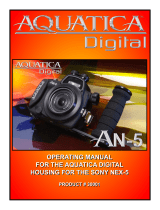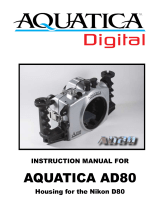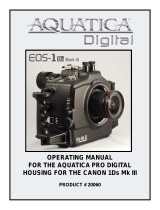Page is loading ...

Product Registration
Please register your product at ikelite.com within 15 days of purchase.
Our product registration database is the best way for us to contact you
in the event of a product update.
200DL Underwater Housing for Panasonic Lumix
DC-G9, DC-G9L
Product Number 71307

2
About this Product
Thank you for your purchase of Ikelite equipment. Please read this
instruction manual completely before attempting to operate or dive
with this product. Please visit ikelite.com to register your product
to receive information on any updates or notices pertaining to your
equipment.
Included in the Box
• Underwater Housing with 200 ft (60m) Back
• Rear O-ring # 0132.61
• Front O-ring # 0132.45
• Base with Left-Hand Quick Release Handle # 4077.67
• Port Hole Cover # 0200.92
• Zoom Gear Retainer # 75900
• Tool for Zoom Gear Retainer # 0945.06
• Waterproof Bulkhead Cap # 9104.5
• Silicone Lubricant # 0184.2
• Control + Pushbutton Tip Assortment # 9249
• 1/16” Hex Key # 0945.16
• 1/8” Hex Key # 0945.18

3
Important Notices
» This housing requires a compatible Lens Port for waterproof
operation. The housing is not waterproof without a Lens Port
attached.
» A bulkhead cap or sync cord must be attached to the housing
for waterproof operation. Never submerge the housing without
either a sync cord or waterproof bulkhead cap attached.
» To prevent salt build-up and sticking controls, turn the camera
off and submerge the sealed housing in clean, freshwater.
Operate the controls several times each while underwater to
ush out any residue.
» Never leave a housing in a rinse tank, even if it is the only
system in the tank. Most catastrophic oods happen when the
user walks away from a housing while it is in the rinse tank.
» Do not use alcohol, cleaning agents, spray lubricants, Rain-X,
or other solvents on the housing or lens port. Use of an
incompatible chemical compound can damage the plastic and
o-rings, and may result in leaking.
» DO NOT remove Vacuum Valve Plug unless you are plugging
in a Vacuum Pump. DO NOT submerge the housing without
the Vacuum Valve Plug installed. The housing will NOT be
waterproof without the Vacuum Valve Plug installed.
» This housing is only compatible with the Panasonic Lumix DC-
G9 Mirrorless Camera as shipped by the manufacturer. Unless
otherwise noted, this housing does not accommodate the use
of add-on grips, battery grips, eyepieces, LCD covers, or other
accessories.

4
Contents
Product Registration 1
About this Product 2
Included in the Box 2
Important Notices 3
Specications 5
Getting to Know Your Housing 6
Vacuum Valve 8
Accessory Port 8
Setting Up Your Camera 9
Pre-Installation Checklist and Initial Camera Settings 9
Setting Up Your Housing 11
Attaching the Base with Quick Release Handle 11
Opening the Housing 11
Inserting the Camera 12
Attaching the Hotshoe 13
Closing the Housing 14
Installing an Optional Zoom Gear (not included with housing) 15
Attaching the Lens Port or Port Extension
17
Final Check 18
Entering the Water 19
Shooting Under Water 19
Setting Up An External Strobe 20
About Sync Cords 20
TTL Strobe Exposure 21
Attaching a Sync Cord 21
Remote Triggering 22
Constant-On Video Lighting 23
Maintenance 23
Post-Dive 23

5
Lens Port 23
Storage 24
Lubricant 24
Push Buttons 25
Control Shafts 26
Troubleshooting 28
Spare Parts
Limited Warranty 30
Service and Repairs 31
Contact Us 32
Specifications
• 200’ (60m) depth rating
• Controls are provided for all important camera functions. Controls
are not provided for Drive mode dial, Diopter adjustment dial,
Joystick, Front dial, F4 Function button, Preview button/F5 Function
button, Function lever, V.MODE button.
• 1/4-20 thread base mounts with 3.5” spacing
• Near neutral buoyancy in fresh water
• Actual buoyancy varies depending on choice of lens and port
• Weight 4.8 lb (2.2 kg) not including tray + handles
• Dimensions 8.9 x 7.3 x 6.5” (226 x 185 x 165 mm) including
projections

6
Getting to Know Your Housing
IKELITE
Shutter Button
Lid Snap
Lens Release
Vacuum Valve
Plug
Mode Dial
Strobe Bulkhead
Connector & Cap
Zoom Control
Quick
Release
Push
Button
External Tray
Quick Release
Handle and Tray
Extension

7
WB White
Balance Button
ON/OFF Switch
Rear Dial
ISO Button
Motion Picture
Button
Button
10
LVF
DISP.
AF/AE Lock
Button
Super-eye
Viewnder
External Tray
Mounting Point
UP Cursor
Control Dial
Focus Mode
Lever
LEFT Cursor
MENU/SET
DOWN Cursor
RIGHT
Cursor

8
Vacuum Valve
Your housing features a Vacuum Valve to check watertightness before
a dive. Use of the vacuum valve requires a pump, sold separately.
» DO NOT remove Vacuum Valve Plug unless you are plugging
in a Vacuum Pump.
» DO NOT submerge the housing without the vacuum valve
plug installed. The housing will NOT be waterproof without the
vacuum valve plug installed.
Vacuum Valve
Vacuum Valve
Plug
Nut
Accessory Port
Your housing features one 1/2-20 threaded Accessory Port which
may be used for attachment of factory optional or aftermarket housing
accessories. Visit ikelite.com for an updated list of factory optional
accessories.
»

9
Setting Up Your Camera
Pre-Installation Checklist and Initial Camera Settings
1. Insert a fully charged camera battery.
2. Insert a properly formatted memory card.
3. Press Mode Dial Lock Button to unlock Mode Dial. Set shooting
Mode Dial to “A” aperture priority mode when a ash is connected
to the housing. Set aperture to F8 for general photography or F22
for macro photography (close-ups). With the ash turned on and
recognized by the camera, the default shutter speed will be 1/60th
second.
If a faster shutter speed is required or no ash is used, set Mode
Dial to “M.” Set shutter speed to 1/125th second for fast moving
subjects. Adjust settings as needed for each shooting situation.
4. Set Metering to “Center-weighted”
.
5. In Flash Menu, set Flash Mode to Forced Flash On and Flash
Synchro to “1st.”
6. Set Red-Eye Removal to “OFF.”
7. Set ISO Sensitivity to “200.”
8. Set Silent Mode to “OFF.”
9. Set Shutter Type to “MSHTR.” A connected ash may not re if this
setting is incorrect.
10. Set Eye Sensor to LVF/Monitor Switch “MON.”
11. In Operation Menu Touch Settings, set Touch Screen to “OFF.”
12. Set Auto Review to “5SEC.”
13. Set AF Assist Lamp to “OFF.”
14. Set Focus/Release Priority to AFS/AFF FOCUS.

10
15. In Touch Settings, set Touch Screen to “OFF.”
Manual Flash can be set on the camera if desired: M,S or A mode
must be used to ensure that the ash will re the red-eye reduction
preashes every time. When red-eye reduction mode is selected
and the shutter release is pressed, 2 short bursts will be red by
the ash with a noticeable delay (about 1/3 of a second) before the
main ash is red. After that, you are now in manual ash mode
and the lightning bolt ash ready indicator will disappear from the
monitor, and there will be no more preashes.
To go back to TTL mode, power the strobe off and then on again.
Then, disable red-eye reduction and set to Forced Flash ON.
AF-ON Function: Instead of half-pressing the shutter button to
focus, you can assign the AF-ON function to the AE-L/AF-L button
in the camera’s menu system to obtain and hold focus. The AE-L/
AF-L button is conveniently accessed by a thumb actuated lever on
the side of the housing.

11
Setting Up Your Housing
Attaching the Base with Quick Release Handle
Using a at head screwdriver, attach the Tray and Handle to your
housing with the two 1/4” nylon washers and 1/4-20 x 3/8” screws.
1/4-20 x 3/8” screw
1/4” nylon washer
Opening the Housing
1. Push lid snap lock toward back of housing and lift the curved end
away from the housing.

12
2. Lid snaps are designed to provide enough force to compress the
o-ring for a proper seal. Keep rm pressure against the lid snap
while lifting it away.
Lid Snap Lock
3. Repeat with remaining lid snaps.
4. Remove the housing back.
Inserting the Camera
1. Remove housing body cap.
2. Remove any lanyard or neck strap which may be attached to the
camera.
3. Remove the camera Mounting Plate from the housing Mounting
Base.
4. Check to see whether the camera’s lens will t through the port
opening of the housing. If not, the lens will need to be removed
from the camera body and re-attached AFTER the camera body is
installed in the housing.

13
5. Line the Mounting Screw up with the Camera Tripod Socket. Use a
coin or at head screwdriver to tighten the mounting plate to the
camera.
Mounting Screw
Camera Tripod Socket
Mounting Plate
6. Pull out on the housing control knobs to move them out of the way.
7. Reinsert the mounting plate into the pocket on the inside bottom of
the housing. Push the camera all the way forward into the mounting
base pocket.
Attaching the Hotshoe
Your Ikelite housing features a factory installed Hotshoe connector
which allows manual ash with Ikelite and non-Ikelite strobes which
feature an electrical bulkhead connection for a sync cord.
The standard Hotshoe provides manual ash exposure, meaning
you must set the power level of your external strobe manually. An
“optional” TTL conversion circuit is available; see page 21.
1. Orient the Hotshoe with the arrow on top pointing towards the front
of the camera.
2. Slide Hotshoe into camera Hotshoe Mount until it stops.

14
» Hotshoe must be all the way forward in the camera mount to
ensure a good electrical connection.
Hotshoe
Hotshoe Mount
Closing the Housing
1. Make sure the o-ring is clean and in its proper location on the back
of the housing. The main housing o-ring does not require lubricant
to make a seal.
2. Place the back onto the housing front.
3. Make sure no controls or wires are interfering with the o-ring or the
back of the housing.
4. Place each lid snap into the corresponding hook on the housing
back.
5. Push the lid snaps toward the housing until they are at against the
housing and the lock has engaged. Close opposing lid snaps at the
same time.
6. Check the o-ring seal. The o-ring should form a uniform, solid line
around the back of the housing. There will be a small, even gap
around the housing between the housing back and the housing
front.
7. Check control functions.

15
Installing an Optional Zoom Gear (not included with housing)
1. Lay housing on its back and remove camera lens by rotating the
housing lens release control, see diagram, page 6.
2. Remove the Zoom Gear Retainer using the Zoom Gear Retainer
Tool.
3. Place Zoom Gear into the Port Mount hole opening with the gear
teeth facing the housing.
Zoom Gear
Retainer Tool
Zoom Gear
Retainer
Zoom Gear
Port Mount

16
4. Replace and tighten the Zoom Gear Retainer using the Zoom Gear
Retainer Tool. Tighten clockwise so Retainer is snug. DO NOT
overtighten.
Zoom Gear
Retainer
Zoom Gear
Port Mount
5. Attach Zoom Clamp to Lens Zoom Ring. If necessary, add foam
rubber strips to inside area of clamp so it properly connects to the
Zoom Gear.
6. Line up Zoom Clamp Slots with Zoom Gear Posts and slide lens
into the housing opening.
7. Bayonet lens into camera and test zoom function.
Zoom Clamp
Zoom Gear
Posts
Zoom Clamp
Slots

17
Attaching the Lens Port or Port Extension
1. Loosen each of the three Thumbscrews so at least 5 threads are
visible. The Thumbscrew should not protrude into the inside of the
port or extension.
Thumbscrew
Sealing
Surface
Drain Hole
Port
Extension
O-ring
2. Make sure the O-ring and Sealing Surface are clean and free of lint,
dirt, or debris.
3. Lightly lubricate O-ring using ONLY Ikelite lubricant. Non-Ikelite
lubricant can cause the o-ring to swell and not seal properly.
Thumbscrew
O-ring
Recess
Dome
Port

18
4. Line up Thumbscrews with Recesses and rmly press the Port or
Extension onto the housing Port Mount.
5. Once Port or Extension is ush with the base of the Port Mount,
tighten Thumbscrews until they are ush against the Port Body.
DO NOT overtighten. If an Extension has been attached to the Port
Mount, attach the Port to the Extension in the same manner.
6. Submerge the completely assembled housing in a bathtub or clean
camera rinse tank and visually conrm there are no signs of water
intrusion. If water does appear to be entering the housing, point the
port downward and remove the housing from the water.
Final Check
1. Re-check the back o-ring seal. The seal should form an even, solid
line around the back of the housing.
2. Turn on the camera and check all control functions.
3. Make sure that the camera can obtain focus and take a photo. This
will not be possible when using a +4 diopter (close-up lens) until
you are underwater.
Adding a +4 diopter to the end of your lens is not normally
necessary unless your lens has a minimum focusing distance of 12”
or LONGER and you are using a dome port. Go to ikelite.com for
additional information about +4 diopter use.
4. Check battery life and available storage space on your memory
card.
5. Submerge the housing in a fresh water tank dedicated to
underwater photography equipment. Visually conrm that there are
no signs of water intrusion. One sign of water intrusion is a steady
stream of bubbles coming from one of the housing seals.

19
Entering the Water
1. Before entering the water, turn the camera on and operate each
of the housing controls to get a feel for using the camera in the
housing.
2. If possible, we recommend entering the water without your housing
to ensure you are comfortable and your life saving equipment is
in working order. Once you are stable, have someone pass your
camera housing to you.
3. Submerge the housing at the surface of the water and visually
conrm that there are no signs of water intrusion or a steady stream
of bubbles coming from one of the housing seals. If water does
appear to be entering the housing, point the lens port downward
and return the housing to the surface as quickly as possible. Please
observe all necessary safety precautions. NEVER ascend faster
than accepted safety limits.
4. Use your hand to gently ush away any small bubbles that may be
on the face of the lens port. Bubbles will produce soft focus spots in
your photo or video.
Shooting Under Water
» It is important to respect all living creatures underwater,
including people, marine life, and coral. While we encourage
people to get close to their subjects when taking a photograph,
we recommend they not touch, lie on, or in any way disturb the
things they nd underwater.
1. Get as close as possible to your subject. For the best results, only
photograph subjects that are less than 6’ (1.8m) away.
2. Be careful not to stir up sandy or silty environments.
3. Photograph subjects straight on or up at a slight angle.

20
4. If you error in exposure, it is better to have the image slightly
underexposed rather than overexposed. An overexposed image
is missing color information which cannot be adjusted in a photo
processing program. A slightly underexposed image has color
information that can be adjusted.
Setting Up An External Strobe
We recommend attaching an external strobe for the optimal color and
clarity in a wide variety of photographic situations, including daylight
photography. This housing provides a direct electrical connection
to the camera’s external ash hotshoe. An external strobe may be
triggered via electrical sync cord. Fiber optic only strobes are not
compatible with this installation.
About Sync Cords
Attaching a strobe via electrical sync cord provides faster strobe
recycle times as compared to a ber optic connection, and prolongs
camera battery life.
Strobes from IKELITE, SEA&SEA, INON, and Nikonos must be used
in manual power modes when connected via electrical sync cord.
» To connect two strobes to the camera, you must use a dual
sync cord.
» Slave strobes may be triggered optically off of a primary
strobe connected by sync cord.
/



